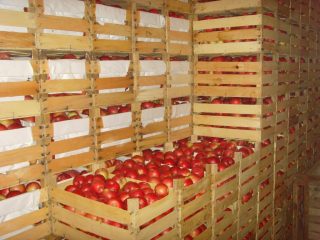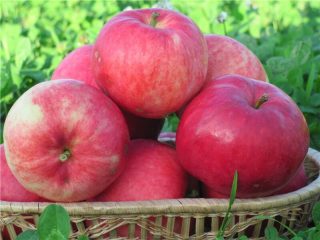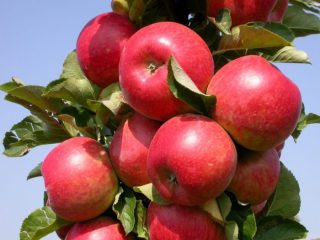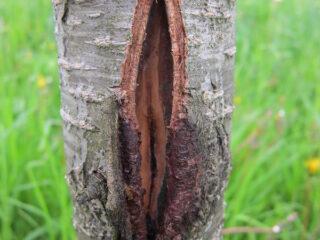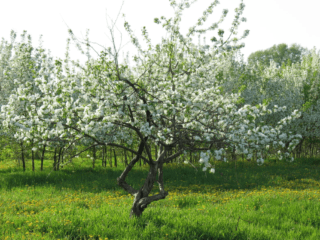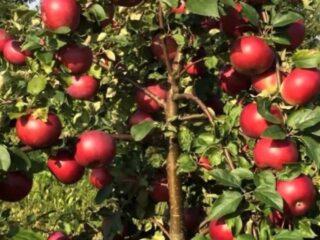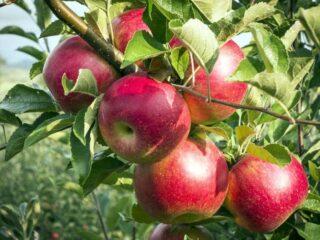Content
Columnar apple tree Pomegranate bracelet is a variety of domestic selection. It attracts gardeners with its abundant fruiting and high decorative properties. When planting and caring, you should take into account the characteristics of columnar varieties.
History of selection
Columnar apple tree Pomegranate bracelet is a domestic variety. They took him out to the Tula region. The author is called Mikhail Vitalievich Kachalkin
Description of the columnar apple tree Garnet bracelet
The Pomegranate bracelet variety is called columnar because the apple tree practically does not form side shoots. The branching of the tree is very weak, and the fruit formations are short. Because of this, the trunk seems to be covered with apples. This structure resembles sea buckthorn. This feature allows the formation of one trunk - the name of the group of varieties appeared due to its resemblance to a column.
Wood appearance
The columnar apple tree Garnet Bracelet has medium vigor. Externally the tree looks like this:
- the height of an adult apple tree is up to 2 m, one-year-old seedlings are 50 cm, by the fifth year of life they grow to 1.3-1.8 m;
- diameter up to 0.5 m;
- lateral branches are present in small quantities;
- leaves are long, medium width;
- petioles red;
- leaf blades are shiny;
- the color of the shoots is red-brown;
- leaves are dark green (yellow in autumn), characterized by red-brown spots;
- the trunk is not exposed;
- flowers are very large, 3 cm each
- The color of the petals is light purple, the shape is ovoid or oval;
- There are 5 buds in an inflorescence.
The flowering time of the columnar apple tree Pomegranate bracelet is average. Usually the buds bloom from late April to May 5th. Flowering lasts six days. During this period, the tree emits a strong and attractive aroma. The apple tree blooms profusely, which ensures its high decorative value.

In the fifth year of life, the annual growth of the columnar apple tree Garnet Bracelet is 20-25 cm
Description of fruits
This columnar variety received the name Pomegranate Bracelet for the thick covering of the trunk with apples and their crimson-red color. Main characteristics of the fruit:
- weight 40 g;
- round shape;
- the presence of a slight waxy coating on the skin;
- the pulp is red.
During the ripening of fruits, the tree is highly decorative.
Characteristics of the variety
Apple tree Garnet bracelet has average heat and drought resistance. This columnar variety begins to bear fruit in the fifth year.
Taste qualities
Apples of the columnar variety Pomegranate bracelet are sweet and sour. Their taste is astringent. The pulp of the fruit is juicy.
Ripening time
Pomegranate bracelet apples ripen by the end of August.According to this parameter, the columnar variety belongs to the autumn variety. The fruits are not suitable for long-term storage. The harvest will last 2-3 weeks.
Productivity
For a columnar apple tree, the yield of the Garnet Bracelet variety is quite high. Don't hesitate to collect it. The safety of ripened fruits on the tree is average.
Frost resistance
In terms of frost resistance, the columnar apple tree Garnet Bracelet belongs to USDA zone 4. This means that the culture can withstand low temperatures down to -31.7-34.4 °C. The variety is also resistant to spring frosts.
Pollinators
Columnar apple tree Pomegranate bracelet is a partially self-fertile crop. This means that it will produce crops even without pollinators. There will be few apples. To get high yields, the proximity of pollinators is necessary. For this purpose, varieties with identical flowering periods are selected:
- Vasyugan;
- Nectar;
- Amber necklace;
- Senator;
- Moscow necklace.
Growing regions
In accordance with frost resistance zone 4, the crop can be grown in most of Russia, including the capital of the country and the Moscow region. When choosing a columnar apple tree Garnet Bracelet for the southern regions, you should take into account that its heat resistance is average.
Disease resistance
Columnar apple tree Garnet bracelet has good immunity. It shows high resistance to most diseases and pests characteristic of the crop. Scab resistance is average.
Advantages and disadvantages
The Garnet bracelet variety is universal. Apples can be eaten fresh or processed.
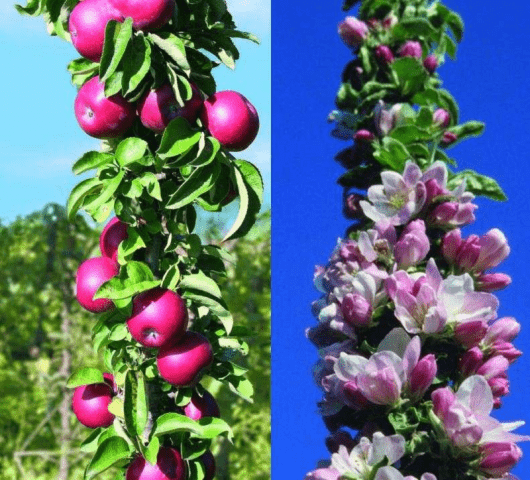
According to consumer reviews, sour apples of the Pomegranate bracelet variety are great for baking
Pros:
- highly decorative;
- compact dimensions;
- good immunity, including average resistance to scab;
- abundant fruiting;
- high frost resistance;
- partial self-fertility;
- excellent commercial quality;
- easier care.
Minuses:
- sour taste of fruits;
- the need for seasonal pruning;
- insufficient drought and heat resistance;
- short shelf life of the crop.
Landing rules
To grow the columnar apple tree Pomegranate Bracelet, you need a well-lit area. Basic requirements for it:
- fertile soil;
- groundwater distance is at least 1.5-2 m from the surface;
- high moisture and air permeability of the earth;
- good drainage;
- soil reaction is slightly acidic or neutral;
- protection from strong winds.
You can plant the columnar apple tree Pomegranate Bracelet in the spring, but not earlier than the first ten days of April, or in the fall - from September 20 to October 10. The hole for the tree is prepared in advance. The optimal size is 0.5 × 0.5 × 0.6 m. The top fertile layer of soil is mixed with the following components:
- peat and humus in equal parts with soil;
- 0.3 kg of wood ash;
- 100 g superphosphate.
At the bottom of the planting hole, drainage is made with a layer of 15 cm. Broken brick or crushed stone is suitable. The further algorithm is as follows:
- Form a mound from the prepared mixture.
- Install the seedling, straightening the roots.
- Fill the hole with soil.
- Water generously.
The root collar is not deepened when planting. It is left above the surface of the earth, which sags after watering.
Columnar apple trees can be planted at intervals of 1 m, leaving row spacing of the same width. Another option is rows with a pitch of 30-40 cm, and between them 1-1.3 m.
Further care
Cultivating a columnar apple tree Pomegranate bracelet requires comprehensive care. One of its measures is systematic watering. It should be done in the evening. The drought resistance of the variety is average, therefore long and severe drying out should not be allowed. A tree uses 1-2 buckets of water. When the buds open, the apple tree is watered generously, then once every two weeks is sufficient. To preserve moisture, the tree trunk circle should be mulched.
From mid-summer, watering is reduced. It is completely stopped in early August. When the harvest is harvested and leaves begin to fall, moisture-recharging irrigation is needed. They consume up to 60-70 liters of water, depending on the rootstock. Water the tree in portions, do not wet the root collar.
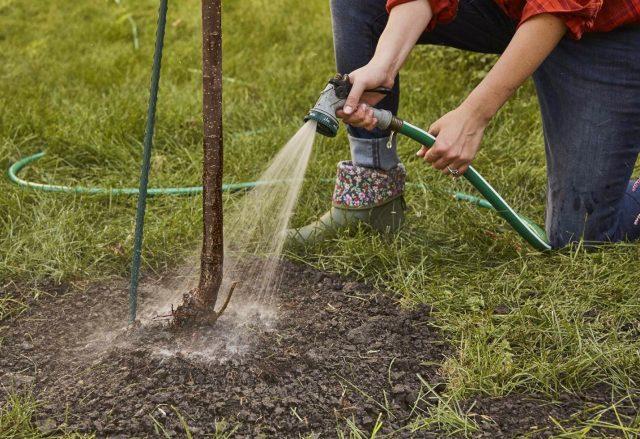
When watering, it is important not to allow the top layer of soil to erode, otherwise nearby roots will be exposed.
When growing a columnar apple tree, Pomegranate bracelet, seasonal pruning is required. Its features are clearly presented in the video:
It is recommended to apply fertilizers in solid form, embedding them to a depth of 1-3 cm. Afterwards, watering is necessary, but without jet pressure. Feed the Pomegranate Bracelet apple tree three times a season. It is optimal to use complex mineral compositions. After each application of fertilizer, the tree is watered and mulched.
In autumn, the tree trunk circle is covered to protect the roots from freezing. You can use leaf litter or sod.
The small size of the tree allows it to be completely covered.You can use burlap or special materials.
Collection and storage
Harvest the Pomegranate Bracelet apples in dry and clear weather. It is better to plan your work for the second half of the day. Harvesting begins from the bottom and south side, where the fruits ripen faster. They are carefully removed and placed in a suitable container.
There is no need to wipe off the waxy coating from apples. It serves as a natural protection and extends shelf life. Only healthy fruits without damage are placed on it. It is better to put them in wooden boxes.
The harvested crop should not be left in the sun or open air. If there is high humidity in the storage room, you can place a container with fluff lime next to the boxes.
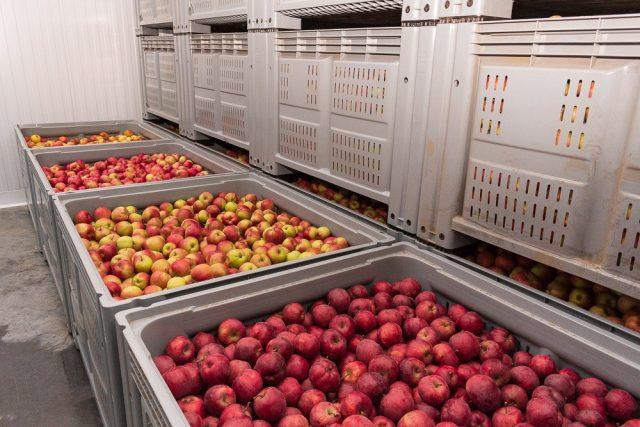
It is better to store apples at a temperature of 0-7 °C, the optimal air humidity in the room is 85-90%
Conclusion
Columnar apple tree Pomegranate bracelet is a domestic variety with high winter hardiness, productivity and good immunity. Its fruits are sweet and sour and have a universal purpose. Trees require comprehensive care, including seasonal pruning and systematic watering.
